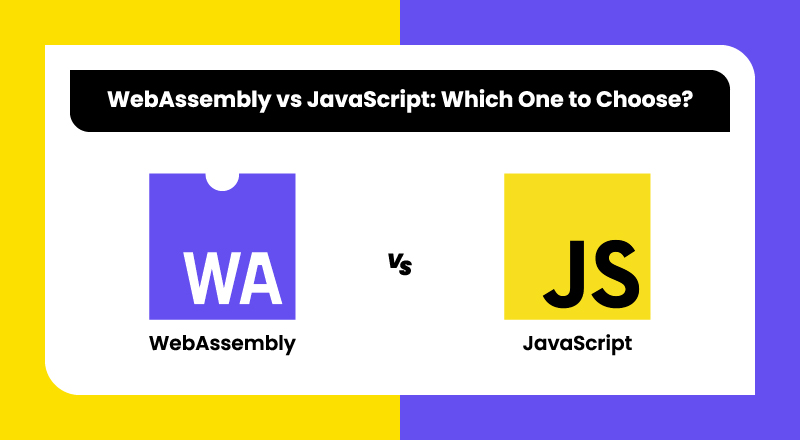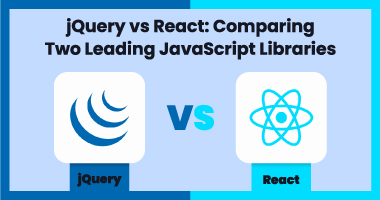WebAssembly vs JavaScript: Which One to Choose?
UpdatedOctober 10th, 2025

Whether creating complex web apps or responsive mobile apps, developers look for robust programming languages to support them.
JavaScript is one such language that has been ruling the charts over the years.
Over the last few years, there has been yet another natively supported programming language compared to JavaScript: WebAssembly, also known as WASM.
WebAssembly vs JavaScript is an interesting evaluation often conducted by developers with respect to multiple features.
WASM and JavaScript have been closely linked, yet each serves its own individual purpose. Initially, the main aim of WebAssembly was to help JavaScript execute more effectively in the web browser.
But now it has moved beyond mere assistance to JavaScript and has become an effective tool on its own. JavaScript acts as the glue that connects WebAssembly modules into web browsers.
WASM and JavaScript integrate seamlessly for a range of applications like browser-driven ML solutions, AR and VR reality apps, browser-based games, etc.
This article compares the two languages, WASM and JavaScript, and answers a few queries: Will WebAssembly take over JavaScript? Is WASM faster than JavaScript? It also discusses WebAssembly vs. JavaScript performance and how WebAssembly may not dethrone JavaScript but has a fanbase of its own.
What is WebAssembly?
WebAssembly (abbreviated WASM ) is a binary instruction format for a stack-based virtual machine. Wasm is designed as a portable compilation target for programming languages, enabling deployment on the web for client and server applications.
WebAssembly is a popular assembly cum programming language that is based on universal low-level bytecode, closer to machine code. It completes compilation and resource loading before execution in the browser.
It is standardized with all major browsers (Google Chrome, Mozilla Firefox, Microsoft Internet Explorer, and Apple Safari), and many programs execute seamlessly, such as Google Earth and Adobe Acrobat’s in-browser app. Developers can execute performance-based business logic code efficiently and quickly.
WASM is a novel type of code that is small, low-level, and has a binary format for a stack-based VM, designed for modernized browsers.
It enables web deployment for server and client-side applications. The Wasm modules provide a compilation target for C, C++, Rust, TypeScript, etc.
Its text format empowers faster and easier collaboration between languages. WebAssembly has been a developer’s favorite for creating high-performance and seamless web apps that can compete with native apps.
WASM is compiled to binary code, resulting in faster performance with high runtime speed.
It has compilers that can compile the preferred language, so coding at a low level is not a challenging task. It makes use of binary format with two files – an executable .wasm file and a text .wat file.
The primary aim of WASM is to execute efficient and modernized browser-based apps with high performance.
There are certain basic concepts on which WebAssembly is built: Values – value types representing listed types like integers, Module – a section of executable machine code compiled by the browser, Table – an array of values of items including pointers, and Functions – organized code blocks that exchange values as parameters.
What is JavaScript?
JavaScript powers thousands of web and mobile apps, and it is one of the most popular programming languages in the software development world. JavaScript’s usage has evolved beyond the client side, and it is being used in server-side, game development, and cross-platform development. Some of the popular JavaScript frameworks are React, Angular, and Vue, among others.
JavaScript is a platform-agnostic language that runs on any device and browser with ease. It is leveraged for mobile and desktop applications, WebUI, and server-side rendering and deployment.
It forms the foundation stone of multiple applications and compiles the code while it runs in the browser. This could lead to slow performance. Developers can develop diverse applications such as web apps, mobile apps, web portals, dynamic websites, and custom JavaScript applications.
JavaScript was meant to be an easy and effective scripting language that can offer interactive web app development. It is developer-friendly and simple, leading to its ever-rising popularity.
JavaScript offers a myriad of benefits and support for modern devices, apps, and platforms. JavaScript is a widely used language in almost all types of web apps and one of the core technologies in the World Wide Web, along with CSS and HTML.
JavaScript offers development services in a wide range of industries, such as supply chain and logistics, education, travel, and hospitality.
All browsers have JavaScript engines for better execution. As an event-driven language, it helps develop interactive and responsive websites with efficacy.
It offers a feature of just-in-time compilation that can create lags for longer tasks but works well with smaller ones.
Developers have also created libraries and frameworks that can optimally unlock the potential of JavaScript.
Here, a browser executes code using the JS engine, which includes a memory stack for allocating memory and a call stack for tracking the program.
Many developers learn about JavaScript through different libraries and frameworks like React.js, Vue.js, Angular.js, etc. It utilizes Google’s V8 engine, which is used by Node.js’s server-side framework.
WebAssembly vs JavaScript: Pros and Cons
Pros of WebAssembly:
- Cross-platform compatibility
- Portability, top-notch security
- Statically typed
- Faster performance and loading times
- Almost native code with no installations
- Compilation of coding language into machine code
- Uses the same web APIs available by JavaScript
- Easy debugging through binary files
- Faster server-side ahead-of-time compilation
Cons of WebAssembly:
- Early stages of development
- Low-level language is hence complicated
- Lack of garbage collection
Pros of JavaScript:
- Compatible with all browsers and devices
- A variety of existing libraries and frameworks
- Execution on the client side saves bandwidth
- Versatile, flexible, easy, and simple to learn
- Interpreted language with optimal performance
- Increased developer productivity
- Enriched user interfaces
- A broad ecosystem of platforms, developers, and frameworks
- Can be used for frontend and backend code development
Cons of JavaScript:
- Inefficient debugging support
- Cross-platform complexities
- DOM interpretation
WASM vs JavaScript: Organizations Using Them
Companies Using WebAssembly:
CloudFlare, Fastly, Retool, American Express, LanzaTech, Google Earth, Hash.ai, Styra, Cubbit, Foretag, Fivnex, Sheetless, etc.
Companies Using JavaScript:
Microsoft, Google, eBay, Walmart, WebClues Infotech, LinkedIn, Groupon, PayPal, Uber, Netflix, Airbnb, Reddit, Instagram, etc.
WebAssembly vs JavaScript: A Quick Comparison
| Parameters |
WebAssembly |
JavaScript |
| Overview |
- Wasm is faster, delivered through a small-sized binary format, and strongly typed.
- It executes complex code effectively and overcomes its load time delay.
- It supports complex and sophisticated operations.
|
- JavaScript is dynamically typed, highly flexible, and delivered in human-readable code.
- It executes effectively when the code is simple because it runs almost instantly, rather than compiling first.
- It supports simple user interactions and app structures.
|
| WASM vs JavaScript Performance |
- It has strong type code, so it is optimized before going to the browser, making it faster.
- In WebAssembly vs. JS performance, it uses small binary files and ahead-of-time processing, and it works faster.
|
- It is an interpreted language, so it will take some time to execute and understand what needs to be done.
- In Wasm Vs JavaScript Performance, it has a long history of usage, with multiple devices and browsers still supporting it.
|
| Security |
Wasm is implemented in a sandbox offering better security |
JS works well for smaller tasks in a completely secure environment |
| Loading Time |
Loading time is fast for heavy computations |
Loading time is fast for small and simple tasks |
| Garbage Collection |
It relies on JavaScript for garbage collection |
It has a detailed garbage collection process for memory management |
| Memory Utilization |
Complicated memory usage, manual management of memory allocations |
JavaScript garbage collection automatically takes care of effective memory utilization |
| API Access |
It does not have direct API access |
It has an extensive platform API access |
| Debugging Facilities |
Since it is a compiled language, debugging takes place before compilation, and hence it is error-free |
Since it is an interpreted language, debugging takes place at runtime, and hence errors may continue to occur. |
| Multithreading |
No support for multithreading can use other low-level languages |
Single-threaded supports multiple executions |
Also Read: TypeScript vs JavaScript: Is TypeScript A New JavaScript?
WASM vs JavaScript – When to Use What?
As you come across a ubiquitous question – ‘Is WebAssembly faster than JavaScript?’, here are certain situations in which you can choose either, based on organizational needs. The decision could vary based on many other parameters, but the following can be a guideline to all:
When Should You Use WebAssembly?
When comparing WebAssembly vs JS performance, there are certain areas and use cases where WebAssembly can fit better.
- Computing-intensive apps
- Apps with encryption of sensitive data
- Hybrid platform apps
- Video rendering/streaming apps
- Music streaming apps
- CPU-intensive games
- Image caching/processing apps
- High-performance scientific simulation apps
When Should You Use JavaScript?
JavaScript has been a developer’s delight for years now. When there is a comparison of WebAssembly vs JavaScript performance, there are specific use cases that are best suited to be developed using JavaScript and its related frameworks:
- Embedded systems
- Desktop applications
- Mobile applications/games
- UI for web apps
- Server-side apps with Node.js
- Creating web and mobile apps
- Building web servers
- Adding interactive behavior to apps
WebAssembly vs JavaScript: On a Concluding Note
Whenever we start comparing WebAssembly vs JavaScript, it feels as if WebAssembly may overtake JavaScript, but that is not possible. It will have its own existence and own fan base, but JavaScript will continue to reign.
Selecting the best option depends on the user case. There are many factors on which the selection of Wasm vs JS depends – availability of productivity tools, project deadlines, budget estimates, skilled resources, knowledge of programming languages, etc.
You need a team of professionals who can help you decide your option and draw a detailed roadmap for your project, leading it to success. You need to select the right IT partner to garner scalability, reliability, and agility in all your business operations.
Our JavaScript developers are well-versed in various JavaScript frameworks and libraries to deliver interactive front-end and robust back-end applications. With SPEC INDIA’s JavaScript development services, you can utilize JavaScript’s versatility to build truly engaging, interactive, and seamless web applications.
Tap into the power of JavaScript to build dynamic and diverse web applications by hiring JavaScript developers from SPEC INDIA. Gain access to top talents with years of experience in different domains and competence to work with modern JavaScript frameworks.
Contact us with all our project details, and we will assist you in finalizing your IT roadmap and selecting your preferred technology stack.
SPEC INDIA is your trusted partner for AI-driven software solutions, with proven expertise in digital transformation and innovative technology services. We deliver secure, reliable, and high-quality IT solutions to clients worldwide. As an ISO/IEC 27001:2022 certified company, we follow the highest standards for data security and quality. Our team applies proven project management methods, flexible engagement models, and modern infrastructure to deliver outstanding results. With skilled professionals and years of experience, we turn ideas into impactful solutions that drive business growth.






